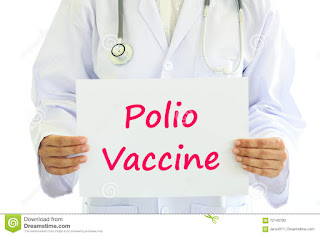Eradicate polio
A world without poliomyelitis: This is the goal of the WHO with its global initiative. High vaccination rates, constant monitoring and the safe handling of polioviruses in laboratories - these are the important cornerstones for the global eradication of polio.
In 1988, the World Health Organization adopted the global initiative to eradicate polio. The eradication of polio is considered to have been achieved if no new case of disease caused by wild-type polioviruses occurs worldwide for three consecutive years. In addition, polioviruses and infectious material that are still present may only be stored and used under strict containment regulations. Europe, America, South-East Asia and the western Pacific are currently considered polio-free.
Poliovirus type 2 eradication
The last case of infection with wild type 2 poliovirus occurred worldwide in 1999. Cases of illness with this virus reported since then can only be traced back to the weakened Sabin strain type 2, which is contained in the live vaccine.
The WHO subsequently declared the global eradication of wild type 2 poliovirus in September 2015. A recurrence of cases caused by poliovirus type 2 should be prevented by
- The type 2 sabin strain is removed from the live vaccine,
- The use and storage of poliovirus type 2 (wild type and vaccine strain) is only allowed in specially certified laboratories (so-called central polio facilities) and
- Any unnecessary poliovirus type 2 material still present in the laboratories is destroyed.
Duties of the BAG
The FOPH is responsible for the safe handling of polioviruses in laboratories. Together with the cantons, it must ensure that the necessary containment measures are strictly observed. As a national coordination point, it covers all laboratories that have wild-type polioviruses, live polio vaccines or potentially infectious material. By keeping the inventory of the laboratories, the FOPH successfully implemented the first phase of the WHO action plan.
We are on the verge of eradicating a human plague - and for the second time in world history. A global public-private partnership has reduced the number of polio cases by 99.9 percent in the last 30 years, but there is still a lot to be done.
And even before we achieve this milestone, the knowledge and infrastructure we have built to fight polio will be repurposed and used for other global challenges.
3 Countries where Polio is still Endemic:
In 2016, fewer than 40 children worldwide contracted polio - the lowest number we have ever had. Here is a dramatic decrease in number from the estimated 350,000 cases per annum in 125 countries in 1985, the year Rotary International launched the worldwide initiative to eradicate this terrible disease.
In 1988 Rotary approved the WHO, the U.S. Centers for Disease Control and UNICEF (and later the Gates Foundation) as partners for the establishment of the Global Polio Eradication Initiative (GPEI).
Today the virus is only found in a few areas in three countries - Pakistan, Afghanistan and Nigeria.
Against this background, Nigeria has intensified its controls in order to narrow down exactly where the virus is still circulating.
Pakistan is using innovative strategies to focus polio vaccination campaigns. Healthcare employees receive further training in the area of cellphone data reporting (data transmission via mobile phone). This enables them to document vaccination coverage and population health surveys in real time.
In Afghanistan, the program is continuously being readjusted in order to be able to vaccinate as many children as possible despite the volatile security situation.
155: the number of countries involved in the largest concerted vaccine switch in history
There are three different strains of the poliovirus. As soon as one strain is eradicated (type 2 was officially eradicated in September 2015), we need to adapt our vaccines to the remaining strains in order to immunize children worldwide.
This transition is a huge undertaking and requires a high level of funding and coordination, because never before has such a feat of health been undertaken on a global scale.
To give you an impression of the scope: The largest and fastest globally coordinated vaccine switch of all time (to combat polioviruses type 1 and 3) was successfully carried out in April 2016 within two weeks and 155 countries took part.
$ 60 billion: The cost of infectious disease epidemics each year
The spread of infectious diseases is consistently among the 10 highest risks in the world in terms of their effects. If we eradicate polio, a child will never again be paralyzed by this terrible plague. But we have to think one step further and use the knowledge and infrastructure that we have built up within the framework of the GPEI to combat other global health threats.
Dramatic advances in improving child health beyond polio are underway and are reflected in declining child mortality rates from other preventable diseases in countries with solid polio infrastructures. Polio vaccinations are now often combined with other important health services, including nutritional assistance, basic health care and other vaccinations.
If we determine where the offers of the polio programs overlap with the priorities for strengthening the health systems of the respective countries, we can have a lasting effect on global health improvement and significantly reduce the disadvantage of poorer countries with regard to the impact of infectious diseases.
World Polio Day
World Polio Day 24th of October was established by Rotary International. On World Polio Day 2020, the WHO Regional Office for Europe urges countries and partner organizations to remain vigilant in the fight against poliomyelitis (polio) - a disease that once claimed millions of lives every year. Thanks to the vaccination measures taken and the strong leadership of the Global Polio Eradication Initiative, an alliance of key partners and key players, the number of wild poliovirus infections has decreased by 99.9% since 1980. The main purpose of this day's celebration is to make World Polio free and awareness.
















1 Comments
Informative
ReplyDelete